Development of sub-chasers: The WWI experience
Submarine-chasers (or “submersible” chasers as they shoud be called) appeared in WWI, developed from sloops and often built by civilian yards. Many were converted trawlers. During the great war, the Russian Imperial navy used for that task a variety of “guard ships”, clearly distinct from gunboats: The Kopchik, Golub and Filin classes (2, 5 and 4 ships respectively). They were gun-armed only, with the exception of Kopchik which also carried mines.
The Kpochik and Korshun were built in 1916, the first discarded in the 1940s ad the second, renamed Pioner sunk in Kronstadt in September 1942. The 450 tons Golub class built in Helsingfors in 1917-19 were all captured, ending in German, then Finnish hands or resold to Chile. The Filin class (1918-19) were sized during completion and went to Finland and Poland or were BU. A 102 mm gun made them efficient against surface submarines, but there are no records of any sinking one. During World War I Russian ASW weapons technology was indeed fairly primitive and ineffective although its possible depth charges were shipped by the entente to Russia before the recolution. The first effective depth charge called the Type D, became indeed available in January 1916.
But again there are no recorded “kill” of a German sub in Baltic waters, which were rare anyway. It should be noted that tthe Soviet Navy also operated aft WWI its first true sub-chasers. In the interwar, three US-built Sc 110 feets sub-chasers were operated, later called the SK class: SK 14, 757 and 758. SK-14 was in fact an ex-French vessel, mined and sunk off Odessa in support of white Russians in 1919, salvaged, repaired and recommissioned in the Red Navy. She was later renamed Gnevnyy and scrapped in 1922. SK-757 and 758 were initially purchased by Bulgaria (from France too) in 1921, later captured by Red Army in September 1944 and operated for a short while like two Romanian vessels. The first had a DCT of the “Y”-gun type and the others combined DC racks and classic launchers.
Armament and tactics of Soviet sub-chasers
Two kinds of ships were used for submarine warfare by the Soviet Navy: The large guardships, a continuation of the versatile WWI concepts, and the dedicated, small sub-chasers built in large numbers, all primarily armed with depth-charges. Dropping depth charges off the stern via a rack or track became standard practice and was already experimented by Soviet Navy destroyers and patrol ships during the interwar. There were no sonars or any acoustic detection devices in the navy nor effective ASW doctrine before WW2 started. About “kills” performed by the Soviet Navy, only 7 German submarines were recorded to have been sunk by depth charges.
A grand total of 88,000 depth charges however were expended in total, many more being used to destroy magnetic mines at that. The “kill ratio” was therefore of around 4280 per submersible (based on 30,000 DCs on submarines). In comparison, 5,174 British depth charge attacks resulted in 85.5 kills, a ratio of 60.5 to 1 while the Hedgehog with 268 attacks had 47 kills, a ratio of 5.7 to 1. No wonder why this type soon became mandatory and was further developed during the cold war.
No Soviet ship possessed sonar until 1941 and all were equipped only from the middle of the war but only 5% of total ships losses experienced by the Soviet Navy were due to submarine attacks anyway. ASW efforts were never a priority for the Soviet Admiralty contrary to the allies notably because of geographic concerns and strategic concern. Nevertheless, the Soviet Navy had a large array of patrol ships that were developed as partial submarine hunter/gunboats, in addition to the versatile “guardships”, sort of large intermediate ships between sloops and destroyers. Tactic-wise, gunnery was still considered the main “sub-killer” when an U-Boat was surprised in surface. Let’s recall there, these were “submersibles”, not submarines. Surface navigation was the rule and not the exception.
After diving, grenades were dropped on the presumed location, or a chase started via hydrophone tracking, when there was one. Soviet naval aviation was never tailored for submarine hunting either, but many were later rearmed with depht-charges and sent patrolling the Baltic or the Black sea. However most of the Morskaya Aviatsiya deployed in this sector was used to sink axis reinforcement shipping, aptrol the Gulf of Bothnia in searhc of targets of opportunity, and a large part of the aviation was deployed to protect the arctic convoys, threatened by the Luftwaffe based in Norway. Read more about the subject.
Depth charges types
-WW1-derived base model (1930): Settings 40 feet (12 m) or 79 feet (24 m). Presumably in stock WW2.
-4B-B model (1930): Settings 40 feet (12 m), 79 feet (24 m), 118 feet (36 m) or 158 feet (48 m). In large stocks ww2.
-BB-1 model (1933): Total Weight 363.7 lbs. (165 kg), warhead 300 lbs. (135 kg) TNT, terminal Velocity 7.55-8.2 fps (2.3-2.5 mps), one setting – Main heavy depth charge of the Soviet Navy in World War II
-BM-1 (1933): 90 lbs. (45 kg), 55.1 lbs. (25 kg) TNT wahread, terminal Velocity 6.9 – 7.55 fps (2.1-2.3 mps), one setting – Main light depth charge.
The Soviet navy used two types of bomb racks:
-B-1 rack: Lever rack, loaded with 20 large BB-1 depth charges.
-M-1 rack: Scoop rack accomodating 32 BM-1 small depth charges models.
–BMB-1 DCP:Main Soviet WW2 Depth Charge Projectors, developed in 1940. They were installed on most Soviet destroyers and had a setting to 43, 87.5 or 120 yards (40 m, 80m or 110m respecitvely) with an elevation going up to 45 degrees. One DC could be fired at a time and the launcher weighted 427.7 lbs. (194 kg). The reload operation was performed by three men with a winch.
Lend-Lease supplies
-British Mark VII Depth charge
-British Mark VIII Airborne Depth charge (used by the naval aviation from 1943)
-USN Mark 10/11 Depth charge projectors supplied with Mk 10 DCs
-USN Mark 20 Depth charge projector and associated DCs.
Guardships and Frigates used for ASW warfare
Uragan class (1929)
img src=”photos/Vikhr-uragan-class.jpg” width=”100%”>
The Uragan class were the first all-purpose patrol ships built in the Soviet Union, planned in the 1926 naval programme in order to replace the old Tsarist-era torpedo boats still used as patrol vessels. They were small vessels intended to deal with any threat, with guns, AA protection and mines, which could be swapped for ASW grenades as well. As the first Soviet designed surface ships their construction was marred with conception and construction problems and they had many issues.
The experience was so painful in this regard, the admiralty turned to Fascist Italy, soon to become its number one designer/provider of ships. This led to the Dzerzhinskiy class built in Ansaldo (launched 1934) for the far east coast guard. Dzerzhinskiy and Kirov were used by the NKVD, commissioned for the Pacific fleet and active in WW2. They brough some input for naval contruction and design that were used for the next guardship classes, Yastreb (8 ships) and Albatros (12 ships) from 1943.
In between, in 1936, the experience of the Uragan class led to the design of the Rubin class (1936), directly developed instead from the successful Tral class minesweepers. Brillant, Rubin, Saphir and Zhemchug were built in Zhdanov yard Leningrad for the northern fleet, used by the NKVD coast guard. Both Brillant and Zhemchug were lost in action.
The Uragan class comprised the Uragan, Tayfun, Smerch, Tsiklon, Groza, Vikhr, Shtorm, Shkval, Metel, Vyug, Grom, Burun, Molniya, Zarnitsa, Purga, Burya, Sneg, Tucha, called internally Proyekt 2 (until Shkval launched at 198 Yd (Marti Yd), Nikolayev in 1930), then the sub-class Metel` (launched 1934), Proyekt 4, with four ships, and proyekt 39, from Molniya (1934) up to Tucha launched in 1936. Most project 2 were built in 190 Yd (Zhdanov Yd), Leningrad, but two at 198 Yd (Marti Yd), Nikolayev and the rest at 190 Yard (Zhdanov), Leningrad and 202 Yard (Dalzavod) in Vladivostok, the last at 190 Yd.
They will be seen in detail in a dedicated article.
Quick specs (Project 2): 450/619 tons, 71.5 x 7.4 x 2.58 m, 2 shaft geared turbines, 2 watertube boilers 6300 hp, 23 knots, 125 tons oil. Armed with two 4-in/60 gns (102 mm), three 13.2 mm DsHK HMGs AA, a single triple 450 mm torpedo tubes bank betwene funnels and 48 minesn or depht-charge racks for ASW grenades. They were used for ASW warfare with little success due to their lack of depht-charge handling equipments and underwater detection devices.
Yastreb/Albatros class (1940-44)
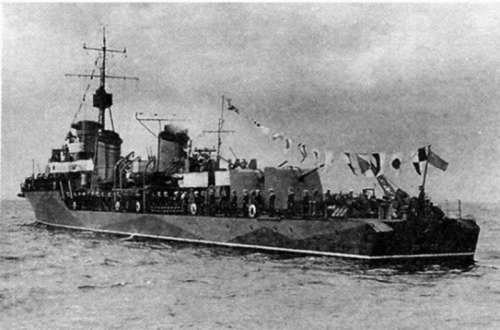
Ships listed: Yastreb, Oryol, Korshun, Sokol, Berkut, Kondor, Voron, Gryf (Project 29/29K Yastreb)
Zorkiy, Chaika, Fregat, Krechet, Orlan, Bditelnyy, Tigr, Leopard, Rys`, Yaguar, Pantera, Tigr, Burevestnik, Albatros (Project 29K Albatros)
They were a development of the Uragan class guard ships with much increased dimensions for improved seaworthiness and better armament. Program was authorized in 1937 and design assignment in December, 1937. In all it was planned to built 30 ships, but only 14 were laid down on most were never completed due to the summer 1941 German invasion.
Quickspecs Project 29 Yastreb: 906/1025 tons FL, 84 x 8.3 x 3 m, 2 shafts geared turbines, 2 watertube boilers, 23,000 shp, 31 knots. Armed with three 100 mm/56 guns, 4x 37 mm AA, 3×2 12.7 mm DsHK AA, triple 450 mm TT, 20 mines or two DC racks (B-1) – 40 DCs. It is not known if they had this time some handling device to reload the racks. Sonars were fitted during WW2.
Quickspecs Project 29K Albatros: 920 tons standard, 8.40 m in beam, reduced machinery with two less boilers for 12.300 shp and 25 knots. Same armament but four twin 12.7 mm DsHk AA mounts. They were authorized by the third five-year plan, 12 laid downbefore the war and distributed between the pacific, and blak sea fleets. The removal of boilers was meant to improve their reduced range by increasing fuel storage massively. Six ucomplete hull were sized by the Germans and scrapped, but Albatros and Chaika were eventually completed in 1945 and Krechet after the war. They were built at 190 Yd (Zhdanov Yd), Leningrad or 820 Yd, Königsberg (Kaliningrad).
Captured guardhips/sub chasers of WW2
–Ametist was the former Estonian torpedo boat Sulev, itself the former German A32 seized by the Soviets after annexing the country in 1940 and assigned to the Baltic fleet. She became an harbor auxiliary in 1942 and scrapped in the 1950s.
–Gangutyec: Former Russian dispatch vessel Sputnik, captured by the Germans in WWI and reused as Möwe in 1918, then handed over to the Estonian Navy, recaptured in 1940. She became for a time the minesweeper T49, then was turned into a guardship in 1941 and lost by mines off Hangö in December the same year.
–Musson, Toros: Former Romanian Sborul and Smeul, themselves former Austro-Hungarian TBs 81T and 83F. Seized in Constanza in 1944 and later returned in 1945.
–O51-54: Ex-German minesweeping boats (R-Boats) scuttled in August – September 1944 by own crews and salvaged by Soviets. Latter boat was captured by Red Army 8.9.1944 and commissioned by Navy one month later.
Lend-lease guardships/sub-chasers of WW2
BO201 class (1943): 138 Transferred
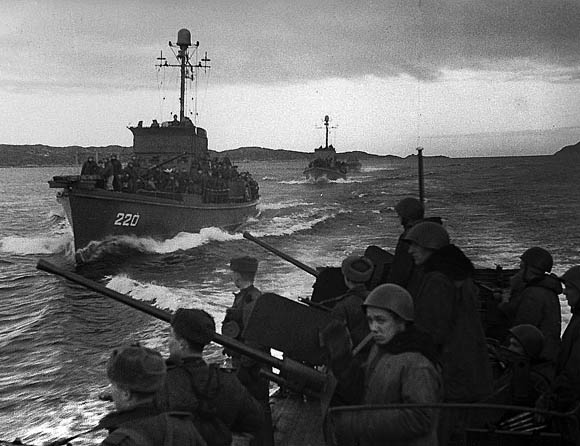
These were USN SC 110ft class submarine chasers, transferred to USSR on lend-lease. There were two certain losses (four for conways), BO-230, sunk 5.12.1944 by German submarine U365 and BO-224 on 2.3.1945 by U995. 12 were delivered to the northern fleet in 1943, and 34 in 1944, 32 to the pacific fleet, and 10 returned to the US in 1955, 29 scuttled in the barentz sea that year, 10 more in the pacific, and the remainder purchased and converted to other roles.
EK-1 class guard ships (1944): 30 Transferred
These were Tacoma-class frigates, transferred to USSR on lend-lease without additional re-equipment and classified as escorts. EK-3 18.12.1948 ran ashore during a storm at Korsakov (Sakhalin), was refloated, repaired, but was used afterwards as depot and accommodation hulk, BU in 1960. All were returned to the USA in 1949.
They were armed with three 76mm/50 Mk 20/21, two twin 40mm/56 Mk 1.2 AA, nine 20mm/70 Mk 4 AA and a 24 tubes 178 Hedgehog MK 10 ASWRL plus 8 DCT and 2 DCR (100 grenades).
MO1 Type (1935): Prototype
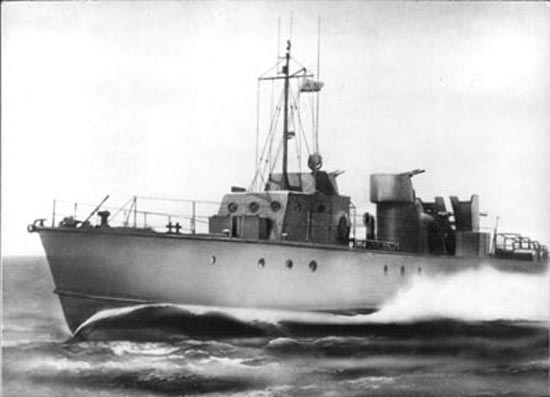
Note: No photos know, this is the OD-200
In the early 1930s, the main focus for the Soviet shipbuilding industry was to create smaller, easier to make patrol ships for various sea duties, either gunboats, or submarine hunters. The MO class was indeed the first Soviet-built, fully dedicated submarine hunter class. The MO abbreviation meaning “Small Hunter” (“Malyj Okhotnik”). Their seagoing abilities were reduced as they were mostly coastal boats, and their armament comprised only depth charge launchers and light defence guns. Still, they were nicknamed “Moshka” (Midge) in Russian service and relatively well liked by their crews. During the war they performed many additional roles, such as supporting landing operations and escorting convoys.
The very first in the serie was the MO-1, a 51 tonnes (50 long tons; 56 short tons) border patrol boat. It was designed and built as PK-139 in Leningrad 5th Yard, but given the class designation of MO-1 in 1935. She was initially built as fast yacht, but actually tested, then adopted by the NKVD Board Guard boat. Still, she was low-powered and lacked the proper speed or armament, so she mostly served as prototype for the improved MO-2 serie and the next mass-produced MO type family. MO-1 was renamed in September 1941 N°0132 and in May 1944 СК-132 (SK-132), and auxiliary at that point. She was discarded in 1946.
Quickspecs: Displacement 51 tons FL, Length 26.0, beam 3.80, draught, 1.20m, 3 shafts petrol engines 1130 shp total, 14 kts, endurance 400 nm at 8 kts. MO-1 was armed with two 12.7/79 mm DsHK HMGs and two DCR (racks) for a crew of 21.
MO2 Type (1935): 6 built
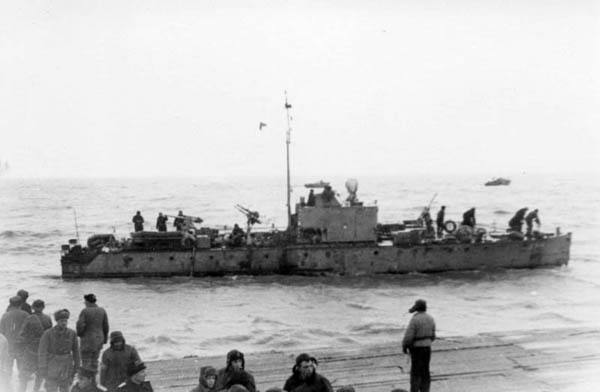
The production series was to be more powerful and slightly faster and better armed. The serie was given the designation MO-2, production records going from 6 to 36 ships built in 1935–1936. The MO-2 was authorized under the second five-year plan as a peacetime NKVD coast guard and wartime sub-chaser. Of wooden construction, still not a satisfactory design, as they ever reached their design speed of 25 knots. They lacked agility and stability as well, while their fuel feeding system was completely unreliable. Approx. six boats built in 1935, more cancelled. A slightly modified MO-3 led to deliver four more ships built, but there is little information available.
MO-2 specifications |
|
| Dimensions | 26 m long, 4 m wide, 1.30 m draft |
| Displacement | 51 tons Full Load |
| Propulsion | 2 shafts GAM-34 ptrol 1,350 bhp 14 kts, 5t petrol |
| Armament | 2x 45mm AA, 2x 12.7mm DsHk, 2 DCR. |
| Crew | 14 |
MO4 Type (1936): 80 built
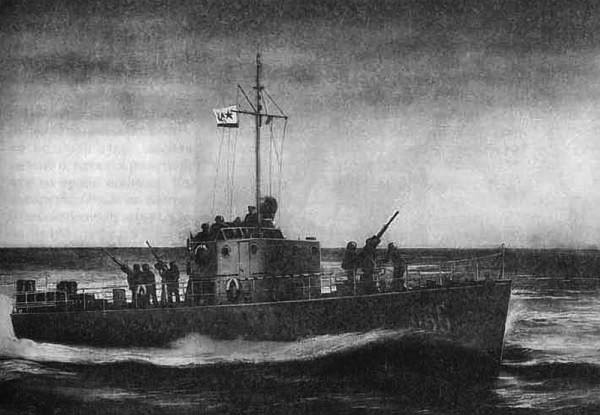
Development history & design
The MO series were designed by a team led naval engineer S. V. Pugavko as a further development of the MO-2 type, to replace and fix all its problems. Unlike the latter, dimensions were slightly increased, the deck was cut at the stern (transom), the beam was reduced by 10 cm (4 in) for a better ratio. They also received more powerful main engines, three GAM-34BS instead of two GAM-34, for a much, much better speed (26 vs. 14 kts). Two prototypes were built in 1936, of mixed construction with a new gearing system giving reverse thrust. Seakeeping qualities, agility and stability were also all greatly improved, but they lacked any sort of ASW specific equipment and were sidelined in WW2 as utilitary patrol boats. They also could carry four large mines.
Like the MO2 in peacetime they carried out normal patrol service for the NKVD maritime border guard, whereas in wartime, they were to track and hunt enemy submarines as well as protecting Russian coastal waters.
Serial construction started the Leningrad plant No.5 (NKVD). Before the war, 187 were built, 75 for the Ministry of Defense to create new flotillas, and 113 as part of the NKVD Maritime Border Guard. Some also joined the Red Banner Baltic Fleet (KBF) and took part in the Soviet-Finnish winter war. Maritime border guards roamed also the coast of Lithuania, Latvia and Estonia after 1940, now part of USSR. After the German invasion, the MO-4 mass-construction program called for several factories, the No. 5, No. 345, No. 640, Astrakhan shipyard and Moscow shipyard (Narkomrech fleet). Despite all difficulties, 74 more MO-4 were still delivered until 1944.
One survived to this day: MO-215, in the “The Road of Life” museum, in the village of Osinovets, a station on the Ladoga Lake. Exposed to the elements is slowly degraded but now it had been preserved, protected by a specially built pavilion, and prepared for full restoration. The serie was split into minor differences:
-The PK-3 border guard boats (MO-4) completed in 1942 and later were given two Packard petrol engines for 2000 shp, 25.5 kts.
-Those completed in 1944-1945 received two single 45mm/65 21KM AA guns or a twin mount, and a single 20mm/70 Oerlikon Mk IV or a twin 25mm/80 84KM and still 2 DCR (8 grenades).
In 1944-45 they were all equipped with a Tamir-1 sonar. Their denomination changed when replaced by MO4 boats as SKA- (Guardboats) from 1943. They were many losses.
A single MO5 was built, launched 9.1941 and also called N°113 at 5 Yd, Leningrad. She was an upgraded version with displacement standard/FL of 58/60 tons, 27.2m long for 4.01m wide and 1.45 Draught, 3 shafts GAM-34BS petrol engines delivering 2,550 shp for 26 kts and 6.2 tons petrol for 700 nm at 15 kts. She was armed with two 45mm/43 21K, and two 12.7mm/79, plus 2 DCR (8) and fitted with a tamir-1 sonar (crew 21).
⚙ Specifications MO-4 |
|
| Displacement | Displacement standard, 53/57 tons |
| Dimensions | 26.9 x 4.02 x 1.48m |
| Propulsion | 3 shafts 3 GAM-34BS petrol engines 2550 hp |
| Speed | 22 knots () |
| Range | Petrol 6.1 tons, Endurance, nm(kts) 367(15) |
| Armament | 2 x 1 – 45/43 21K, 2 x 1 – 12.7/79, 2 DCR (8) |
| Crew | 21 |
Battle records of the MO4
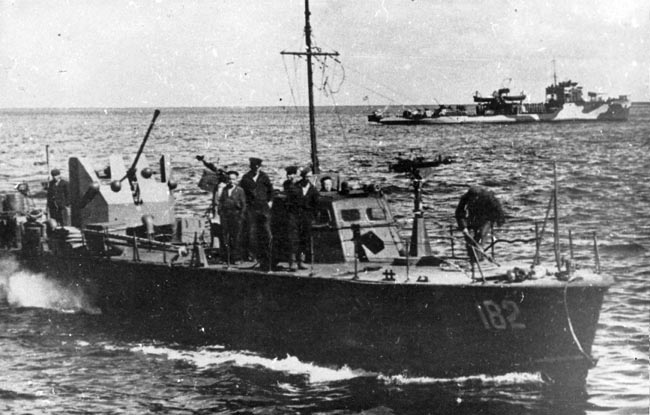
MO4s in the Black sea were named “SKA” or patrol boats and indeed acted that way since axis submarines in this area were very few: Only the Romanian ones, and at some point, U-19, U-20, and U-23 also operated there, as well as most of the CM type midget subs of the Regia Marina. On 3 July1942 SKA-0112 and SKA-0124 evacuating soldiers fro Sevastopol were attacked by S-28, S-40 S-42 and S-102. Both were sunk, 37 sailors and soldiers captured, including a soviet general. S-28 had one killed, the S-40 was heavily damaged (3 killed, 10 wounded), 11 months in repair.
On 25 July 1942 SKA-0175 and the MTB TK-154 attacked and sunk the German schooner n°2412. On 20 November 1943 SKA-031, SKA-0141 and SKA-0512, covered by a Che-2 seaplane depth charged the German submarine U-18, forced to return to base, repaired until the end of January 1944. SKA-84 was the most decorated among them: She destroyed two enemy patrol boats and one aircraft, escorted a total of 184 ships in convoys, sweeped 20 sea mines and was the first ship in the Soviet Navy to have the naval 82 mm (3.2 in) Katiusha variant. She ended sunk by field artillery on September 11 1943 off Novorossiysk.
In the Baltic, on 25 August 1942, Ladoga Lake, MO-206, MO-213 and MO-215 ambushed and captured off Vekkosaari the Finnish motorboat E-32. On 23 May 1943 Finnish patrol boats VMV-8, VMV-9, VMV-10, VMV-11, VMV-17 attacked MO-207 and MO-303. This was inconclusive, the two forced breaking away. MO-207 had its commander killed and 3 wounded. VMV-17 had one killed, one wounded but the MTB Raju was claimed sunk, while the Finns claimed both MO4 boats. On 14 May 1944, MO-122, MO-202, MO-213, MO-401 and MO-413 clashed with S-76, S-79, S-91, S-132, and S-135. MO-122 was sunk (9 killed) while S-91 had two wounded.
On 26 May 1944, MO-104, MO-302 and MO-313 engaged S-91, S-97, S-114, and S-135 in another epix small boat clash. The Commander of MO-302 was killed and 2 sailors, 11 wounded and the boat badly damaged. S-97 was also badly damaged (3 killed, 1 wounded) and another on S-114. On 15 July 1944, MO-104 and MO-105 teaming with the MTBs TK-47 and TK-57 to badly damage the surfaced U-679, cauht off-guard. A torpedo missed the submarine but it was badly damaged by gunfire before submerging with 8 sailors wounded.
On 20 July 1944 MO-103 depth charged and sunk U-250 in low waters so the crew escaped, its captain and 5 sailors were captured. The Soviets recovered the wreck and captured an Enigma machine plus the new Zaunkonig German acoustic torpedoes, and this intell was passed to the allies right away. On 9 May 1945 MO-121, MO-122, MO-131, MO-204 (MO-4 class) and the D-3 MTBs now used as PBs n°175, n°176, n°177, n°183, n°192 plus other smaller boats intercepted a Kriegsmarine convoy with escaping Latvian collaborationists on board. An armed tug was sunk, Rota surrendered and the barge n°833. Another barge and two schooners were scuttled but the tug Una escaped with 100 passengers. In all, 670 were captured, a coup for soviet propaganda and probably the last naval action in this sector of the war.
In the Arctic, MO4 mostly were used for mine-laying purposes, as they were enough lend-lease allied vessels for ASW patrols. From March 1942 to the end of the war, MO4 mines claimed the German merchant Utlandshorn (2643 GRT), German auxiliary TB Schiff-18 Alteland, the Westsee (5911 GRT), Hans Rickmers (5226 GRT), the patrol ship V-5909 Coronel, the Norwegian tug Pasvik, the German Antje Fritzen (4330 GRT), patrol ship V-6016, the tanker Mil. MO-121 and MO-163 clashed with German forces on 15 April 1943, together with MO-123 and MO-133 destroying a defecting cargo, Shchuka on the German shore.
In the Pacific, quieter theater, there were just two notable actions: On 10 August 1945 the Japanese merchant Riuko Maru n°2 (2230 GRT) was captured by Border Guard patrol boats off the mouth of river Vorovskaya (405 POW) and on the 19th, PK-31 shelled and repelled the Japanese schooner Maoka off the Shakalin island (Src wio.ru).
BO2 Type (1939): 2(+15) built

The first large Soviet sub-chasers/sub hunters of WW2. Programmed in the third five-year plan, they were much delayed due to the lack of manpower and resources, only 11 planned for service in January 1939 and 17 laid down, two commissioned before 1945 and 15 completed after. The first five were given Soviet diesels, the remainder US supplied General Motors diesels, and they were built at Krasnaya Sormovo Yard in Gorki, Zelyenodork Yard in the Volga, 42 Yard in Molotovsk, Diomedes inlet yard near Vladisvostok. They directly inspired the larger Project 122.
⚙ Specifications BO2 |
|
| Displacement | Displacement standard, 240/280 tons |
| Dimensions | 49 x 5.8 x 2m |
| Propulsion | 3 shafts GAM-34? petrol engines 3,600 hp |
| Speed | 22 knots |
| Range | Petrol 18 tons, Endurance, nm(kts) 1200(12) |
| Armament | 1x 76mm/55, 2x 37mm/67 AAn 3 LMGs, 2 DCR (8) |
| Crew | 30 |
BO 163 class large sub-chasers (project 122/122a/122bis)
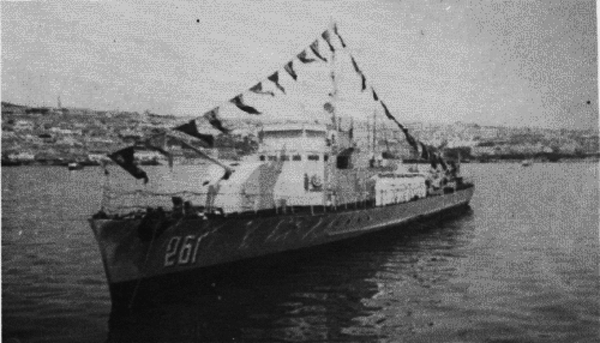
These were large seaworthy boats used as patrollers in coastal or close offshore waters in peacetime as well as anti-submarine hunters in wartime, built for Border Guard (NKVD) and Navy: Project uniform was approved on 2.3.1939. Armament comprised a single 76mm/55 gun 34-K, a single twin and two single 12.7mm MGs DShK and 16DC heavy machine guns. In 1939-1940 plant No340 started the first four project 122 boats for the Border Guard. All the rest of the order was built for the Navy as war was slooming, called project 122a. Plant 402 in Molotovsk adopted riveting instead of welding, and the boat in general had a larger displacement and length while the speed was cut down to 18kts, but traded for increased range. Their superstructure was modified as well as their armament.
They were built at 300 Yd (Leninskaya Kuznitsa), Kiev, 340 Yd, Zelenodolsk, and 402 Yd, Molotovsk, six laid down 1939, five in 1940, six in 1941 and the rest in 1943 and 1944 (as well as many in 1945 and postwar). Around 300 boats were ordered, and within, about twenty cancelled. They diverged in specs beteween Project 122, 122a and 122bis. The latter was armed for example with one 85mm/52 90K gun, on 37mm/73 70K AA, two twin 12.7mm/79 HMGs, two quintuple 250 RBU-1200 DCT, one DCR (36) and 18 mines, plus the Lin` or Neptun radar, Tamir-10 or Tamir-11 sonar (will be developed in the cold war section).
Project 122 boats received a Tamir sonar later in the war. Project 122a boats had a Tamir-1 installed since the origin. They were armed in addition with two 37mm/63 70K AA guns, but late war boats had a single 85mm/49 90K, two single 37mm/63 70K AA, two twin 12.7mm/79 HMG AA, two DCTs, and one DCR (55)
After WW2 ended, construction shifted towards the new improved project 122bis, built until 1955, with a new ASW armament and Tamir sonar. They stayed in service in the early cold war and some were sold to China. In the cold war years they returned to their patrol duties for the NKVD as the OKhT-1 TOPAZ border guard ships (projects 122, 122bis) until 1955-60 but some survived into the 1970s.
⚙ Specifications BO-163 |
|
| Displacement | Displacement 340/380 tons |
| Dimensions | 56.6 x 6.6 x 2.20m |
| Propulsion | 3 shafts 9D diesels, 3,300 hp, 23 kts |
| Range | 18 tons oil, Endurance 1750 nm/12 kts |
| Armament | 1x 76mm/52 34K, 3x 12.7mm/79, 2 DCR (72) |
| Crew | 49 |
BMO Type (1939): 48 Built
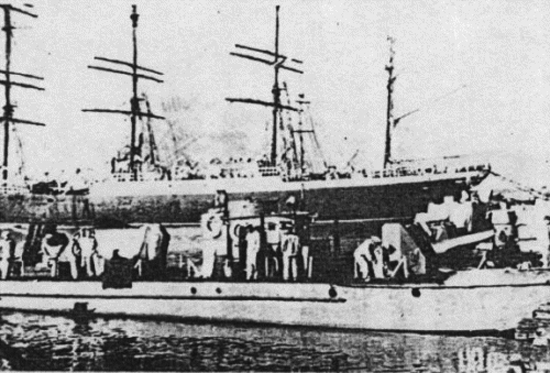
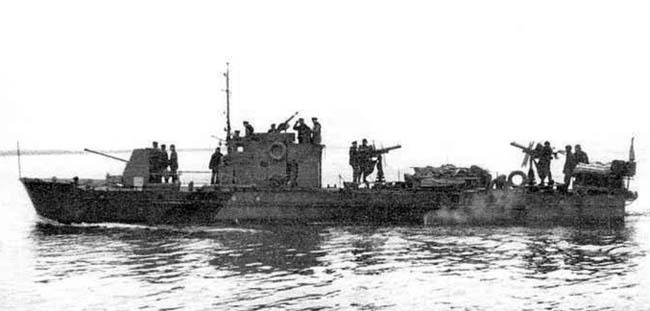
These were armoured small submarine chasers designed and built in Leningrad during the siege with whatever was available. This predetermined a number of prominent features like a simpler rectilinear hull form, a steel hull mostly riveted, and all vital parts like the engine room oil tanks and deck house received additional armour to defeat bullets and shrapnels. They were also equipped with two main Packard W8 petrol engines and a single cruising motor ZIS-5. Conways states they displaced 74 tons but most sources point out 55.
Also, a number of D3 class motor torpedo boats were pressed into service as TK class patrol/guard boats, most repurposed, but others were completed as such, as they proved too slow for regular MBT duties. See Soviet WW2 MBTs
⚙ Specifications BMO type |
|
| Displacement | Displacement standard, 53/55 tons |
| Dimensions | 24.8 x 4.20 x 1.60m |
| Propulsion | 3 shafts, 2 W8 petrol, 1 ZIS-5, 2400 hp |
| Speed | 21 knots (6 kts) |
| Range | Petrol 7.2 tons, Endurance, 495 nm/8.4 kts |
| Armament | 1x 37mm/63 70K, 2×2(+1) 12.7mm/79, 2 DCR or 10 mines |
| Crew | 22 |
Sources/Read More
Conway’s all the world’s fighting ships 1922-47.
Soviet Warships 1941-45: Volume IV Armament, by A.V. Platonov
S. V. Patyanin, Ships of the Second World War, Soviet Navy 1941-1945
Moscow Magazine, “Sea campaign” No. 3 (24) for 2009
G. Smirnov “Stories about Weapons”, M, Detlit, 1976.
Directory “Ships and vessels of the Soviet Navy 1928-1945”.
and-kin2008.narod.ru
operation-barbarossa.narod.ru
russ-flot.narod.ru
navalmuseum.ru
en.wikipedia.org
On navypedia.org
On wio.ru
Reconstitution on o5m6.de
MO4 On navypedia.org
Artillerist On navypedia.org
uragan
yastreb
Russian guardships on navypedia (generic)
Passage on Google Books
Youtube video New sub-chasers war on U-boats – 1942



 Latest Facebook Entry -
Latest Facebook Entry -  X(Tweeter) Naval Encyclopedia's deck archive
X(Tweeter) Naval Encyclopedia's deck archive Instagram (@navalencyc)
Instagram (@navalencyc)





 French Navy
French Navy Royal Navy
Royal Navy Russian Navy
Russian Navy Armada Espanola
Armada Espanola Austrian Navy
Austrian Navy K.u.K. Kriegsmarine
K.u.K. Kriegsmarine Dansk Marine
Dansk Marine Nautiko Hellenon
Nautiko Hellenon Koninklije Marine 1870
Koninklije Marine 1870 Marinha do Brasil
Marinha do Brasil Osmanlı Donanması
Osmanlı Donanması Marina Do Peru
Marina Do Peru Marinha do Portugal
Marinha do Portugal Regia Marina 1870
Regia Marina 1870 Nihhon Kaigun 1870
Nihhon Kaigun 1870 Preußische Marine 1870
Preußische Marine 1870 Russkiy Flot 1870
Russkiy Flot 1870 Svenska marinen
Svenska marinen Søværnet
Søværnet Union Navy
Union Navy Confederate Navy
Confederate Navy Armada de Argentina
Armada de Argentina Imperial Chinese Navy
Imperial Chinese Navy Marinha do Portugal
Marinha do Portugal Mexico
Mexico Kaiserliche Marine
Kaiserliche Marine 1898 US Navy
1898 US Navy Sovietskiy Flot
Sovietskiy Flot Royal Canadian Navy
Royal Canadian Navy Royal Australian Navy
Royal Australian Navy RNZN Fleet
RNZN Fleet Chinese Navy 1937
Chinese Navy 1937 Kriegsmarine
Kriegsmarine Chilean Navy
Chilean Navy Danish Navy
Danish Navy Finnish Navy
Finnish Navy Hellenic Navy
Hellenic Navy Polish Navy
Polish Navy Romanian Navy
Romanian Navy Turkish Navy
Turkish Navy Royal Yugoslav Navy
Royal Yugoslav Navy Royal Thai Navy
Royal Thai Navy Minor Navies
Minor Navies Albania
Albania Austria
Austria Belgium
Belgium Columbia
Columbia Costa Rica
Costa Rica Cuba
Cuba Czechoslovakia
Czechoslovakia Dominican Republic
Dominican Republic Haiti
Haiti Hungary
Hungary Honduras
Honduras Estonia
Estonia Iceland
Iceland Eire
Eire Equador
Equador Iran
Iran Iraq
Iraq Latvia
Latvia Liberia
Liberia Lithuania
Lithuania Mandchukuo
Mandchukuo Morocco
Morocco Nicaragua
Nicaragua Persia
Persia San Salvador
San Salvador Sarawak
Sarawak Uruguay
Uruguay Venezuela
Venezuela Zanzibar
Zanzibar Warsaw Pact Navies
Warsaw Pact Navies Bulgaria
Bulgaria Hungary
Hungary

 Bundesmarine
Bundesmarine Dutch Navy
Dutch Navy Hellenic Navy
Hellenic Navy Marina Militare
Marina Militare Yugoslav Navy
Yugoslav Navy Chinese Navy
Chinese Navy Indian Navy
Indian Navy Indonesian Navy
Indonesian Navy JMSDF
JMSDF North Korean Navy
North Korean Navy Pakistani Navy
Pakistani Navy Philippines Navy
Philippines Navy ROKN
ROKN Rep. of Singapore Navy
Rep. of Singapore Navy Taiwanese Navy
Taiwanese Navy IDF Navy
IDF Navy Saudi Navy
Saudi Navy Royal New Zealand Navy
Royal New Zealand Navy Egyptian Navy
Egyptian Navy South African Navy
South African Navy






























 Ukrainian Navy
Ukrainian Navy dbodesign
dbodesign